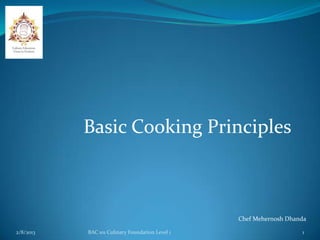
06 basic cooking principles
- 1. Basic Cooking Principles Chef Mehernosh Dhanda 2/8/2013 BAC 101 Culinary Foundation Level 1 1
- 2. Scope After this session you will be able to: Know what is heat How heat is transferred to foods What is the effect of heat on different constituents of food 2/8/2013 BAC 101 Culinary Foundation Level 1 2
- 3. What is Heat? Heat is a type of energy. When the food item is heated, the molecules absorb this energy they vibrate rapidly, expand & bounce off each other causing the transmission of heat. The faster the molecules move, the higher is the temperature. 2/8/2013 BAC 101 Culinary Foundation Level 1 3
- 4. Heat Transfer Transmission of heat occurs by: Conduction Convection Natural Mechanical Radiation Infrared Microwave • Induction 2/8/2013 BAC 101 Culinary Foundation Level 1 4
- 5. Conduction The movement of heat from one item to another with direct contact. 2/8/2013 BAC 101 Culinary Foundation Level 1 5
- 6. Convection The transfer of heat through a medium (liquid/ gaseous) There are two types of convection, namely Natural Mechanical 2/8/2013 BAC 101 Culinary Foundation Level 1 6
- 7. Natural convection Natural convection occurs due to the tendency of warm liquids/gasses to rise upwards while cooler ones fall 2/8/2013 BAC 101 Culinary Foundation Level 1 7
- 8. Mechanical convection Mechanical convection requires a fan or stirring action to circulate heat quickly & evenly. 2/8/2013 BAC 101 Culinary Foundation Level 1 8
- 9. Radiation Radiation method does not require physical contact between the heat source & the food, instead the heat energy is transferred by waves of heat or light which strike the food There are two types of radiation heat transfer, namely Infrared Microwave 2/8/2013 BAC 101 Culinary Foundation Level 1 9
- 10. Infrared radiation Infrared radiation uses high temperature electric/heat sources which transfer the energy as radiant heat to the food. Eg: The coils of an electric toaster 2/8/2013 BAC 101 Culinary Foundation Level 1 10
- 11. Microwave radiation Microwave radiation uses high frequency waves which penetrate inside the food & agitate the water molecules , causing friction which in turn increases the temperature & results in cooking 2/8/2013 BAC 101 Culinary Foundation Level 1 11
- 12. Induction Induction heating is the process of heating an electrically conducting object (usually a metal) by electromagnetic induction Heat is generated directly in the pot or pan (cooking vessel), as opposed to being generated in the stovetop by electrical coils or burning gas 2/8/2013 BAC 101 Culinary Foundation Level 1 12
- 13. Effects of Heat on Foods Carbohydrates Fruit and vegetable fiber Proteins Fats Minerals, vitamins, pigment, and flavor components Water 2/8/2013 BAC 101 Culinary Foundation Level 1 13
- 14. Proteins coagulate Starches gelatinize Sugars caramelize Water evaporates Fats melt Fiber is softened Vitamins and pigments can be destroyed 2/8/2013 BAC 101 Culinary Foundation Level 1 14
- 15. Cooking Times Consider: The cooking temperature The different speeds of heat transfer The size, temperature, and individual characteristics of the food 2/8/2013 BAC 101 Culinary Foundation Level 1 15
- 16. Group assignment Prepare a word document of 500 words on any of the following topics: 1. Green fuels/Eco friendly fuels for commercial food preparation (e.g. Solar cooking) 2. Conserving energy costs in a commercial hotel kitchen 2/8/2013 BAC 101 Culinary Foundation Level 1 16
- 17. Thank You Sir, didn’t you have a full-faced beard 3 seconds ago? 2/8/2013 BAC 101 Culinary Foundation Level 1 17
